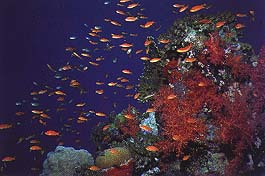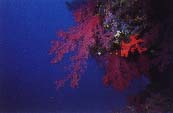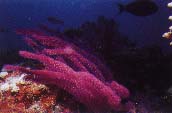by W. Gladstone and R. Khuzaiym
Pictures by F. Jack Jackson & Jürgen Kuchinke
 Coral reefs are as much a part of Arabia's natural heritage as the deserts and bedu way of life. The entire Arabian peninsula is fringed by some of the most beautiful coral reefs in the world, reefs which have been used by seagoing Arabs for thousands of years. And like the animals and plants of the desert which have successfully adapted to this extreme climate, so have the Arabian coral reefs adapted to conditions not experienced by coral reefs elsewhere, such as high water temperature and salinity.
Coral reefs are as much a part of Arabia's natural heritage as the deserts and bedu way of life. The entire Arabian peninsula is fringed by some of the most beautiful coral reefs in the world, reefs which have been used by seagoing Arabs for thousands of years. And like the animals and plants of the desert which have successfully adapted to this extreme climate, so have the Arabian coral reefs adapted to conditions not experienced by coral reefs elsewhere, such as high water temperature and salinity.
Despite their adaptations to harsh conditions, coral reefs are sensitive to unnatural disturbances, and the most destructive unnatural disturbances are caused by humans. We smother coral reefs with sand from dredging, we pollute them with sewage, oil and chemical wastes, and we overfish. Coral reefs need our protection.
In the Red Sea we are fortunate that most coral reefs are healthy, apart from some near the larger coastal cities and developments. The best way to keep them in this excellent state of health is to act now by conserving and protecting them.
One of the areas with a high priority for conservation in the Arabian Red Sea is the Farasan Islands. These islands, numbering more than 120, are fringed by beautiful coral reefs, seagrass beds and mangroves. The waters are inhabited by important and endangered species such as turtles, whales, dolphins and dugong. Most of the reefs are pristine and rarely visited by outsiders. The beaches are used as nesting grounds by turtles, and some are recognized as internationally and regionally important sites for waterbirds. The Farasan Islands are also culturally important because some traditional Saudi maritime activities still occur there and nowhere else, such as artisanal fishing by Saudi nationals, pearl diving and the annual gathering of harid parrotfish.
To protect this unique natural heritage the National Commission for Wildlife Conservation and Development decided to establish a marine protected area around the Farasan Islands. To conserve the marine environment of the Farasan Islands we first needed accurate information about the marine flora and fauna and the extent and impact of human activities.
During our surveys we discovered two human activities which had damaged parts of the coral reefs - anchoring and clam collecting. A reef which had been used by fishermen for many years had suffered from countless anchors dropped amongst the coral to steady the boats whilst fishing. The area is no longer used for fishing but the corals have never recovered their former beauty. The seafloor is littered with the remains of smashed coral branches, creating a colourless and lifeless landscape. Fishes which depend upon the coral for their food and shelter, such as the beautiful butterflyfishes, have disappeared.
 Clams were also collected from the same reef and sold in Farasan village. Populations of marine animals can sustain some harvesting, but our surveys revealed that in some places the clam populations had been reduced by as much as 50 per cent over a very short period of collecting. As this had been ongoing for many years it was almost impossible on some parts of the reef to find any living clams. Our old friends from Farasan village also told us that the clams being sold in the village nowadays were much smaller than those in the past, a first sign that too much collecting had occurred and the ecology of the clams was suffering.
Clams were also collected from the same reef and sold in Farasan village. Populations of marine animals can sustain some harvesting, but our surveys revealed that in some places the clam populations had been reduced by as much as 50 per cent over a very short period of collecting. As this had been ongoing for many years it was almost impossible on some parts of the reef to find any living clams. Our old friends from Farasan village also told us that the clams being sold in the village nowadays were much smaller than those in the past, a first sign that too much collecting had occurred and the ecology of the clams was suffering.
The collectors also appeared to be choosing the largest clams, which is significant because of the unusual biology of clams. The largest clams have functional male and female reproductive organs, whereas the smaller clams have only the female organs (the male organs developing later in life). Removing only the largest clams will leave a surviving population dominated by females, limiting the ability of individuals to successfully breed and replenish themselves. Clams also have a role to play as one of the many species of animals which filter the seawater passing over the coral reefs. The destruction of corals and the loss of clams could affect the health of the reef and the animals and plants inhabiting it. Unfortunately, clam collectors also contributed to the general degradation of the reef by smashing corals to gain easy access to the clams.
Reefs recover naturally from disturbances, but it can be a slow process. Corals replenish themselves by budding, and by sexual reproduction. Budding can take many years to restore the coverage of coral, especialy if most of the coral in an area was destroyed. In sexual reproduction eggs and sperm are broadcast into the open water where the fertilized egg floats for a few weeks before it swims to the bottom and begins its search for a suitable vacant space on a reef (by the time it is ready to settle the young coral has probably floated far away from its parental reef). In a similar way clams broadcast their eggs and sperm into the open water, relying on chance and the ocean currents to bring the two together to create a fertilized egg which will develop into a young clam.
The reefs which had suffered from careless anchoring and excessive clam collecting are in a sheltered bay far away from the streams of ocean currents. As a result, the process of natural recruitment and recovery would be very slow in this area. The Wildlife Commission therefore decided to assist the natural recovery process and rehabilitate the area by transplanting living corals and clams. Rehabilitation of coral reefs has been successfully accomplished in other parts of the world following catastrophes such as ship groundings, but we believe this is the first time that rehabilitation was attempted in the Middle East.
Our rehabilitation work involved transplanting corals and clams
from healthy areas into the  damaged reefs. Several different species of corals were selected in an effort to reconstruct the diverse coral community which existed there before the anchors inflicted their damage. Corals were collected from over a large area to avoid damage to another part of the reef. Branches were selected and gently snapped. This does not permanently injure the remaining colony or the branch, and the broken stump of the branch will weld naturally over time to a clean rocky substrate, eventually growing into a large colony. For the smaller species the whole colony was picked up and transplanted to a secure lodging in the damaged area. The coral branches were secured in place to ensure that the natural welding process began quickly and was not disrupted by the movement of the coral.
damaged reefs. Several different species of corals were selected in an effort to reconstruct the diverse coral community which existed there before the anchors inflicted their damage. Corals were collected from over a large area to avoid damage to another part of the reef. Branches were selected and gently snapped. This does not permanently injure the remaining colony or the branch, and the broken stump of the branch will weld naturally over time to a clean rocky substrate, eventually growing into a large colony. For the smaller species the whole colony was picked up and transplanted to a secure lodging in the damaged area. The coral branches were secured in place to ensure that the natural welding process began quickly and was not disrupted by the movement of the coral.
We collected clams from a reef where they were abundant, being careful to gather them from over a large area so that the local population would not be depleted. This reef was far away from the damaged reef so we transported them by car to their new home. They were handled gently and kept covered and moist at all times to prevent drying-out. In the damaged area we positioned the clams on the reef slope and the reef crest to replicate the original distribution of clams in the area before it was disturbed. Clams are heavy so we simply placed them on the bottom without securing them. Shortly after arriving in their new home the clams were open and filtering seawater, a good sign that they had survived their journey and had begun establishing themselves. The work was hard and physical and we spent many days in the water, but it was all worthwhile.
 Without further disturbance the populations of corals and clams
will return to their former levels. The area will be checked regularly
to monitor the progress of the rehabilitation. Of course, this
is only half the solution. These sorts of operations must be complemented
by public education, especially about careful anchoring (see box)
and sustainable use to ensure that the same problems do not happen
again in the future.
Without further disturbance the populations of corals and clams
will return to their former levels. The area will be checked regularly
to monitor the progress of the rehabilitation. Of course, this
is only half the solution. These sorts of operations must be complemented
by public education, especially about careful anchoring (see box)
and sustainable use to ensure that the same problems do not happen
again in the future.
Please Anchor Carefully
Hints for environmentally friendly anchoring around coral reefs
One of life's great pleasures is exploring the clear, rich waters of coral reefs and discovering the great diversity of animals and plants which live there. Many people own boats and visit the reefs of the Red Sea and Gulf at their leisure, or they join dive charter boats. The number of people and boats visiting coral reefs is increasing every year, so the pressure on coral reefs also increases, and there is only a limited number of reefs. Continued use of the same area of a reef will lead to destruction of the coral by anchors and eventually damage to the reef's ecology - unless preventive actions are adopted. And these actions do not mean restricting people's enjoyment.
One of the simplest ways that damage can be prevented is by careful anchoring practices. Careful anchoring around coral reefs does not mean unsafe anchoring. Here are a few guidelines.
* Plan your exploration beforehand and go with the weather - choose the safest part of the reef, where the waves are smallest.
* Take a little extra time and look for the lighter coloured sand patches (amidst the darker patches of reef which appear brown-green from the boat) to lower your anchor onto, rather than lowering it directly on to the coral. There are many sand patches around coral reefs and choosing one should not severely limit your access. If you are diving in deep water lower the anchor carefully and adjust it once you have reached the bottom.
* Use a sand anchor which will dig into the sand and provide a strong hold.
* Let out sufficient rope so that the force of the boat rocking in swells is taken up by the anchor rope. The rope should be atached to the anchor by a long length of chain to prevent chafing on hard surfaces and the possible loss of your boat
* Once you are in the water check the anchor first. Dig it deeper into the sand if necessary, or move it so that the chain is not damaging nearby corals. If there are no sand patches, then secure the anchor around a coral head and clear the chain so that it will not damage surrounding corals as the boat swings
* If you are moving the boat at the end of the dive loosen the anchor before you surface so that it will come up easily and it will not be necessary to drag it out with the force of the engines, which always damages a large amount of coral
* One of the most effective ways of protecting a well visited coral reef is to install a mooring to which you will tie up every time you visit the reef and cause no extra damage to the coral. This technique is now being used by commercial tour operators in many parts of the world as a way of protecting their valuable resource.
| Subjects | Search
Arabian Wildlife. Volume 3, Number 1